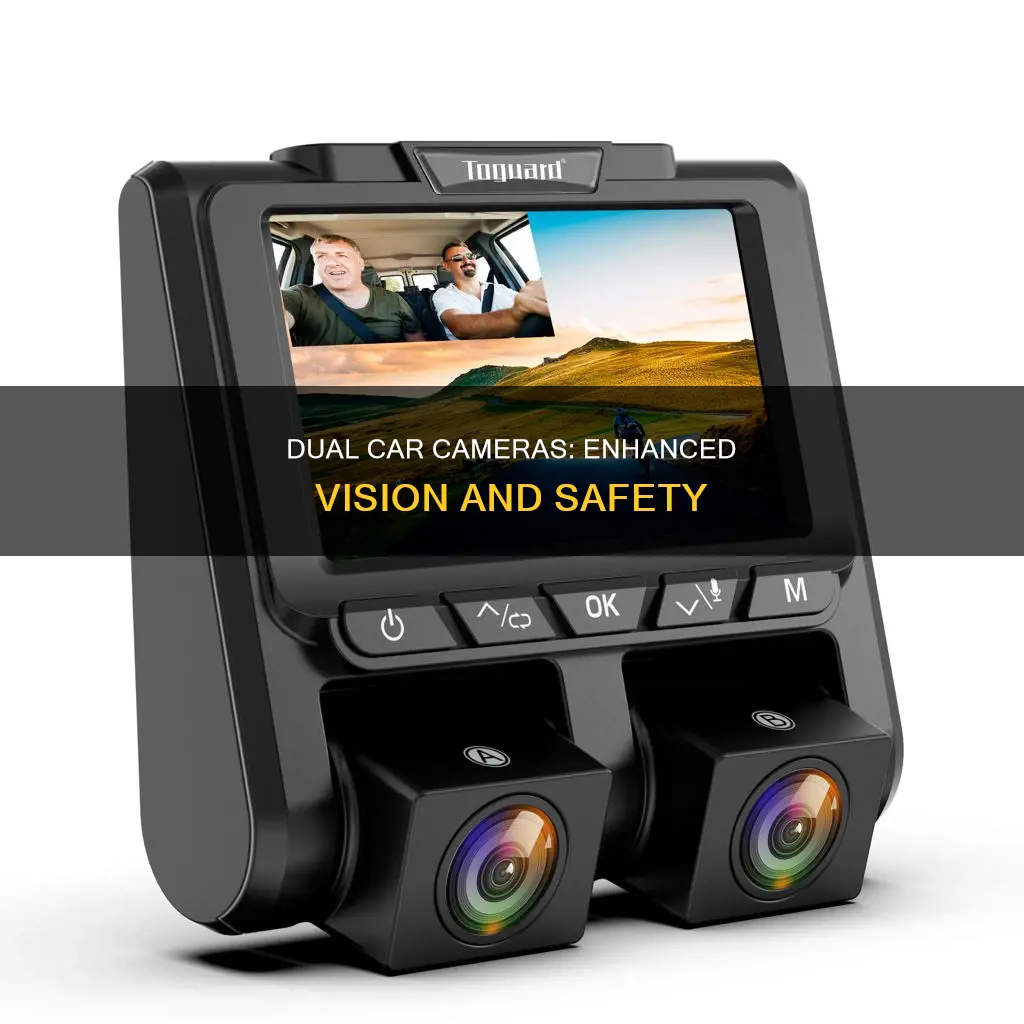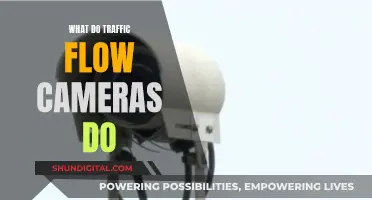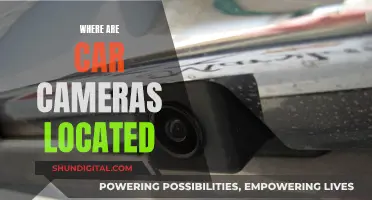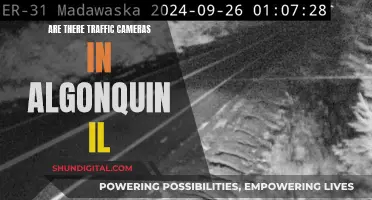
A dual camera for a car, also known as a dash camera, is a device that can be installed in your vehicle to record footage in front and behind it while you drive. These cameras are useful in the event of a road accident, as they can provide evidence of what happened. They often include a forward-facing camera and a smaller rear camera, with the latter being useful for determining blame after a rear-end collision.
| Characteristics | Values |
|---|---|
| Resolution | 1080p, 1440p, 2K, 4K |
| Frame rate | 30fps, 60fps, 120fps |
| Dimensions | 40 x 65 x 75mm, 65 x 110 x 36mm, 85 x 55 x 40mm, 86 x 33 x 52mm, 98(L) x 55(W) x 30(D)mm, 10" |
| Power supply | 12V socket, USB, battery, hardwiring kit, car's OBD port |
| Parking mode | Yes, No |
| Subscription available | Yes, No |
| Features | GPS, G-sensor, night vision, loop recording, collision warning systems, lane departure warning, motion detection, etc. |
What You'll Learn

Dual cameras can record footage in front and behind your vehicle
The front-facing camera typically captures the road ahead through the windscreen, while the rear-facing camera is usually mounted on the rear screen or near the license plate, offering a view of the road behind. These dual camera systems are often called 2CH dash cams and come with various features and specifications.
When choosing a dual camera system, consider the resolution and frame rate of both cameras. While 4K resolution is available for the front camera in some high-end models, it is less common for the rear camera, which often has a lower resolution. The frame rate also varies, with 30 frames per second (fps) being common, but some cameras offering 60 fps for smoother footage.
Another factor to consider is the field of view. A wider lens angle, such as 170 or 180 degrees, can capture more of the scene, providing a broader perspective. Additionally, look for features like GPS, speed camera detection, parking mode, and Wi-Fi or Bluetooth connectivity for easy file transfer.
Keep in mind that dual camera systems often require professional installation due to the long cable connecting the front and rear cameras. Alternatively, some cameras can be powered through the vehicle's OBD port or 12V lighter socket, offering a more accessible setup.
Overall, dual cameras that record footage in front and behind your vehicle provide a valuable layer of protection and evidence in the event of a collision or road incident, making them a worthwhile investment for any driver seeking enhanced security and peace of mind.
HDR Mode: Capturing Stunning Photos with Your S8 Camera
You may want to see also

They can be used to determine blame after a rear-end collision
A dual camera for a car, also known as a 2CH dash cam, is a system that includes a regular forward-facing camera and a smaller rear camera. The front camera is usually mounted on the windscreen, while the rear camera is typically attached to the rear screen with an adhesive pad. These cameras can also be powered by a single cable attached to the car's 12v lighter socket or by a hardwiring kit connected to the vehicle's fuse box.
Now, regarding determining blame after a rear-end collision, these dual-camera systems can be incredibly useful. In such incidents, it is generally assumed that the driver who hits the car in front is at fault. However, this is not always the case. Here's how dual cameras can help:
- Evidence Collection: In the event of a rear-end collision, a dual-camera setup can provide valuable evidence by recording the road ahead and behind. This footage can help establish what happened, identify who was at fault, and support insurance claims or legal proceedings.
- Identifying Fault: By reviewing the footage, it can be determined if the driver of the rear vehicle was following too closely, driving recklessly, or engaging in distracted driving. This evidence can be crucial in assigning blame to the appropriate party.
- Multi-Vehicle Collisions: In cases of multi-vehicle collisions, or chain-reaction accidents, the footage from dual cameras can help unravel the sequence of events and identify which drivers are at fault.
- Brake Check Incidents: If a driver in front suddenly brakes hard without warning, a rear-end collision may occur. The footage from dual cameras can clarify if the front driver intentionally brake-checked or if there was an unannounced circumstance or mechanical failure that led to the abrupt stop.
- Lane Change and Signaling Issues: Dual cameras can capture instances of unnecessary lane changes without proper signaling, reckless driving behaviour, or failure to signal, which can all contribute to rear-end collisions.
- Non-Functioning Brake Lights: In some cases, the rear-ending driver may not be at fault if the car in front had non-functioning brake lights or turn signals. The footage from dual cameras can help establish if the front vehicle's lights were operational.
- Comparative Fault: In certain jurisdictions, such as Connecticut, there are comparative fault laws. This means that fault can be apportioned between the drivers, and compensation may still be recovered if a driver is found to be less than 50% at fault. Dual cameras can help determine the degree of fault for each party involved.
Overall, dual cameras in cars can provide crucial evidence to determine blame after a rear-end collision. They offer a real-time review of the events leading up to the accident and can assist insurance companies, legal professionals, and law enforcement in establishing fault and assigning liability.
Mounting Your Camaro 360: The Perfect Car Companion
You may want to see also

They can be powered by a car's OBD port
A dual camera for cars, also known as a two-channel or 2CH dash cam, consists of a forward-facing camera and a smaller rear camera. The rear camera usually attaches to the forward-facing camera with a long cable and can be affixed to the rear window with an adhesive pad.
Dual dash cams can be powered by a car's OBD (On-Board Diagnostics) port, which is present in all modern vehicles (models from 1996 onwards). The OBD port is typically located to the left of the steering wheel or underneath the steering column.
Using the OBD port to power a dual dash cam offers several advantages. Firstly, it provides a simpler and more convenient method for parking-mode recording compared to hardwiring the camera to the vehicle's fuse box. The OBD port is usually more accessible than the fuse box, which can be located in different places depending on the vehicle. Additionally, hardwiring a dash cam to the fuse box can be a complex process that may require professional installation.
Another benefit of using the OBD port is that it provides a constant power supply to the dash cam. The OBD port is always connected to the car battery, ensuring that the dash cam receives uninterrupted power. This is important for the reliable operation of the camera, especially when the vehicle is parked and the ignition is turned off.
However, there are a few considerations to keep in mind when powering a dual dash cam through the OBD port. Firstly, the OBD port may not provide a switched power source, which means the dash cam may not turn on and off with the vehicle's ignition. This can be addressed by using a dash cam model that has a parking mode setting or by using an OBD cable with a switch to enable parking mode.
Additionally, using the OBD port for power may raise concerns about battery drain, especially if the camera is left on for extended periods when the vehicle is parked. To mitigate this, some OBD cables have an energy-saving mode that helps reduce power consumption when the vehicle is not in use.
In conclusion, powering a dual dash cam through a car's OBD port offers a convenient and reliable solution for drivers who want a simple installation process and uninterrupted power supply for their dash cam. However, it is important to consider the specific features and settings of the dash cam and OBD cable to ensure optimal performance and avoid potential issues.
Where's the Adjustment Brush? Camera Raw's Essential Tool
You may want to see also

They can be used for surveillance and security
Dual cameras for cars can be used for surveillance and security. They can be used to record trips and capture evidence in the event of unforeseen incidents or accidents on the road. These cameras can be attached to both the front and rear screens of a car and are often equipped with features such as parking mode, night vision, and wide-angle lenses to ensure that all important details are captured. Additionally, some dual-camera systems include a cabin camera, which can be useful for ridesharing or taxi drivers.
The footage recorded by these cameras can provide valuable evidence in the event of a road accident, insurance claim, or dispute. It can also help determine blame after a rear-end collision. With built-in features like GPS, speed and lane departure warnings, and headway monitoring, these cameras offer a comprehensive view of a vehicle's surroundings and driving behaviour.
Some dual-camera systems also support Google Maps, allowing users to view their vehicle's driving track, speed, and location. This information can be valuable for insurance purposes and can provide a detailed record of a trip or journey.
It is important to note that the installation of dual cameras may require professional assistance, especially when dealing with long cables and power connections. Additionally, some cameras offer expandable memory through microSD cards, which can be useful for storing longer trips or for those who use their dual-camera systems frequently.
Police Car Cameras: Always Recording?
You may want to see also

They can be used to monitor driving and review footage
Dual cameras for cars can be used to monitor driving and review footage. They are usually set up to record the road ahead and the road behind, which is useful for determining blame after a rear-end collision. They can also be used to record footage inside the car, which is especially useful for ride-share drivers.
Dual dash cameras are often comprised of a regular forward-facing camera with a smaller rear camera. The resolution of the second camera is usually lower than the front, and it attaches to the forward camera with a long cable. The rear camera usually sticks to the rear screen with an adhesive pad, although some models are designed to attach to the rear of the car, close to the license plate.
Dual dash cameras are useful for monitoring driving and reviewing footage in the event of an accident. They can help to prevent disputes and fraudulent insurance claims, as well as capture evidence during unforeseen incidents on the road. The footage can also be used to improve driving habits and identify areas for improvement. Additionally, dual dash cameras can provide peace of mind and added security when driving or leaving your car parked.
When choosing a dual dash camera, consider the video resolution, frame rate, and field of view. Look for cameras that offer high-quality video with a resolution of at least 1080p (Full HD), ideally with HDR and a frame rate of 30 fps or higher. A wider field of view will capture more of the scene, while a narrower field of view may be more discreet. Other features to consider include GPS, parking mode, and voice control.
It is important to note that dual dash cameras may require professional installation, especially if they need to be hardwired to the car's fuse box for a constant power supply. Additionally, some dual dash cameras may have subscription fees for additional features such as cloud storage and advanced driver assistance systems.
Solar Power for Your Swann Cameras: A Guide
You may want to see also
Frequently asked questions
A dual camera for a car, also known as a dash cam, is a device that you mount on your car's windshield or dashboard to record footage of the road ahead and/or behind your vehicle.
A dual camera can provide valuable evidence in the event of a road accident or incident. It can also help with insurance claims and dispute resolution.
Some features to consider are video quality (look for at least 1080p Full HD resolution), night vision, parking mode, GPS, and a wide field of view.
Dual cameras typically have a long cable that connects the front and rear cameras. You can tuck this cable into the gaps between and behind your car's interior panels and roof lining. For power, you can either plug the camera into your car's 12V lighter socket or hardwire it to the vehicle's fuse box, which may require professional installation.
Yes, there are single-channel dash cams that only record the road ahead. These are generally more affordable, but a dual camera provides additional coverage in case of a rear-end collision.







